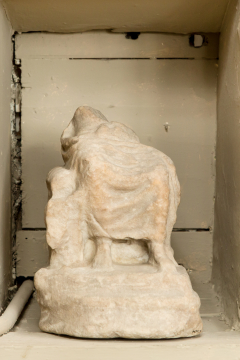Explore Collections


You are here:
CollectionsOnline
/
Fragmentary statue of the enthroned Jupiter
Browse
Fragmentary statue of the enthroned Jupiter
Pentelic marble
Height: 25cm
Width: 17cm
Length: 13cm
Width: 17cm
Length: 13cm
Museum number: M757
On display: Dome Area
All spaces are in No. 13 Lincoln's Inn Fields unless identified as in No. 12, Soane's first house.
For tours https://www.soane.org/your-visit
Curatorial note
This much mutilated fragment consists of the lower part of a male figure - a statuette of Jupiter, seated on a throne, set on a rectangular, podium-like base. The himation was draped over the lower waist and legs and across the throne in the traditional manner; the arms, back support, and decorated cushion-seat of the throne are carved out. On the lap, set diagonally across the right thigh, there appear to be traces of the fulmen, most of which was broken away with the right arm. The remains of two little feet, a right wing, and bird's tail behind at the right leg indicate the presence of the now missing Eagle attribute.
Small, shrine statuettes of the enthroned Jupiter, based ultimately on the colossal figure of the temple of Jupiter Capitolinus in Rome, were popular throughout Italy and the Western provinces. This mutilated statuette belongs to that class of figures, and if we assume a date later than the Flavian period it reflects the third temple image rather then the two destroyed by civil strife and fire during that period. Following the general lines of this type, of which the ultimate ancestor if the Olympian Zeus of Pheidias, the left arm was raised and held a sceptre staff vertically, (see A. Zadoks Jitta in JRS XXVIII, 1938, pp. 50-55, pls.II-V).
The work of the Soane statuette is cursory and finds its best parallel among those figures found in the confines of Roman Gaul; compare a small statue from Bitburg and now in the Trier Museum (?) for a more complete example of this type of sculpture, (Espérandieu, VI, p.423, no.5245). Several similar statuettes come from the Nijmegen area and are in the local museum (Espérandieu, IX, p.43f., nos. 6618, 6620, 6621; see also nos. 6574, 6599, etc. The last in the Bonn Museum, shows, as in our example, the fulmen on the lap, in the right hand).
The heroic-scale marble Zeus, a Graeco-Roman version of a Hellenistic cult-image, from the Villa d'Este in Tivoli by way of Marbury Hall in Cheshire and now in the J. Paul Getty Museum, Malibu, California, gives the intermediate prototype. The Marbury-Getty statue transmitted the Pheidian creation to the rustic artists of the Latin West. See A. Michaelis Ancient Marbles in Great Britain, p.501, no.1; also Hersperia 1975.
Small, shrine statuettes of the enthroned Jupiter, based ultimately on the colossal figure of the temple of Jupiter Capitolinus in Rome, were popular throughout Italy and the Western provinces. This mutilated statuette belongs to that class of figures, and if we assume a date later than the Flavian period it reflects the third temple image rather then the two destroyed by civil strife and fire during that period. Following the general lines of this type, of which the ultimate ancestor if the Olympian Zeus of Pheidias, the left arm was raised and held a sceptre staff vertically, (see A. Zadoks Jitta in JRS XXVIII, 1938, pp. 50-55, pls.II-V).
The work of the Soane statuette is cursory and finds its best parallel among those figures found in the confines of Roman Gaul; compare a small statue from Bitburg and now in the Trier Museum (?) for a more complete example of this type of sculpture, (Espérandieu, VI, p.423, no.5245). Several similar statuettes come from the Nijmegen area and are in the local museum (Espérandieu, IX, p.43f., nos. 6618, 6620, 6621; see also nos. 6574, 6599, etc. The last in the Bonn Museum, shows, as in our example, the fulmen on the lap, in the right hand).
The heroic-scale marble Zeus, a Graeco-Roman version of a Hellenistic cult-image, from the Villa d'Este in Tivoli by way of Marbury Hall in Cheshire and now in the J. Paul Getty Museum, Malibu, California, gives the intermediate prototype. The Marbury-Getty statue transmitted the Pheidian creation to the rustic artists of the Latin West. See A. Michaelis Ancient Marbles in Great Britain, p.501, no.1; also Hersperia 1975.
Unrecorded
Literature
Michaelis, p. 476.
Soane collections online is being continually updated. If you wish to find out more or if you have any further information about this object please contact us: worksofart@soane.org.uk


